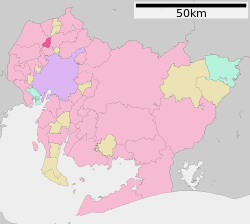Iwakura, Aichi
Iwakura
岩倉市 | |
|---|---|
 | |
 Location of Iwakura in Aichi Prefecture | |
| Coordinates: 35°16′46″N 136°52′17.1″E / 35.27944°N 136.871417°E / 35.27944; 136.871417 | |
| Country | Japan |
| Region | Chūbu (Tōkai) |
| Prefecture | Aichi |
| Government | |
| • Mayor | Katsurao Kubota (from January 2017) |
| Area | |
| • Total | 10.47 km2 (4.04 sq mi) |
| Population (October 1, 2019) | |
| • Total | 47,929 |
| • Density | 4,600/km2 (12,000/sq mi) |
| Time zone | UTC+9 (Japan Standard Time) |
| - Tree | Camphor Laurel |
| - Flower | Rhododendron |
| Phone number | 0587-66-1111 |
| Address | 1-66 Sakae-cho, Iwakura-shi, Aichi-ken 482-8686 |
| Website | Official website |
Iwakura (岩倉市, Iwakura-shi) is a city located in Aichi Prefecture, Japan. As of 1 October 2019[update], the city had an estimated population of 47,929 in 21,805 households,[1] and a population density of 4,578 persons per km². The total area of the city was 10.47 square kilometres (4.04 sq mi). It is the city with the smallest area in the prefecture (followed by Takahama and Chiryū), and is the 10th smallest city in Japan.[2] Iwakura city is famous for its "Cherry Blossom Festival" which mostly takes place around the end of March every year. Iwakura's cherry blossom is located at the symbol of the city "Gojo river" and lists as one of the top 100 best cherry blossom spots in Japan.
Geography

Iwakura is located in the Nōbi Plain region of northwest region of Aichi Prefecture, in the center of former Owari Province. The beautiful Gojō River flows through the city, which, despite its inland location, has an elevation of only eight to twelve meters above sea level.
Climate
The city has a climate characterized by hot and humid summers, and relatively mild winters (Köppen climate classification Cfa). The average annual temperature in Iwakura is 15.6 °C. The average annual rainfall is 1758 mm with September as the wettest month. The temperatures are highest on average in August, at around 28.2 °C, and lowest in January, at around 4.3 °C.[3]
Demographics
Per Japanese census data,[4] the population of Iwakura has been growing over the past 70 years.
| Year | Pop. | ±% |
|---|---|---|
| 1940 | 9,521 | — |
| 1950 | 13,029 | +36.8% |
| 1960 | 14,431 | +10.8% |
| 1970 | 38,843 | +169.2% |
| 1980 | 42,800 | +10.2% |
| 1990 | 43,807 | +2.4% |
| 2000 | 46,906 | +7.1% |
| 2010 | 47,329 | +0.9% |
Surrounding municipalities
History
Origins~Middle Ages
The area of modern Iwakura was settled in the Jōmon period and Yayoi period and was dominated by shōen feudal estates during the Heian and Kamakura periods.
Early modern period
During the Sengoku period, it was ruled by a branch of the Oda clan. The area is also the ancestral home of the Yamauchi clan, who dominated Tosa Province under the Edo period Tokugawa shogunate.
Late modern period
With the establishment of the modern municipalities system after the start of the Meiji period, the village of Iwakura was established within Niwa District, Aichi Prefecture in 1889. It was raised to town status in 1892, and expanded through merger with three neighboring villages in 1906.
Contemporary history
Iwakura was elevated to city status on December 1, 1971.
Government

Iwakura has a mayor-council form of government with a directly elected mayor and a unicameral city legislature of 15 members. The city contributes one member to the Aichi Prefectural Assembly. In terms of national politics, the city is part of Aichi District 10 of the lower house of the Diet of Japan. Iwakura City Hall has been recognized as one of the most prestigious local government organizations in Aichi prefecture. [citation needed]
Economy
Iwakura was traditionally noted for sericulture. Currently, agriculture and light manufacturing dominate the local economy.
Secondary sector of the economy
Manufacturing
Ishizuka Glass Co., Ltd. is headquartered in Iwakura.
Education
Schools
Iwakura has five public elementary schools and two public middle schools operated by the city government and one public high school operated by the Aichi Prefectural Board of Education. There is a large amount of residents in Iwakura from Brazil and city hall public information is always distributed in both English and Portuguese. Iwakura has an education system which promotes foreign language and cultures. [citation needed]
Transportation

Railways
Conventional lines
- Inuyama Line:- Taisanji – Iwakura – Ishibotoke -
Roads
Expressways
Japan National Route
Local attractions
- Iwakura castle
- Iwakura city historic park
-
Iwakura castle
-
Iwakura city historic park
References
- ^ Iwakura City official statistics (in Japanese)
- ^ "愛知県で最も市域が小さい岩倉市の特徴 | 不動産の教科書". www.toshinjyuken.co.jp. Retrieved 2023-07-13.
- ^ Iwakura climate data
- ^ Iwakura population statistics
External links
![]() Media related to Iwakura, Aichi at Wikimedia Commons
Media related to Iwakura, Aichi at Wikimedia Commons
- Official website




